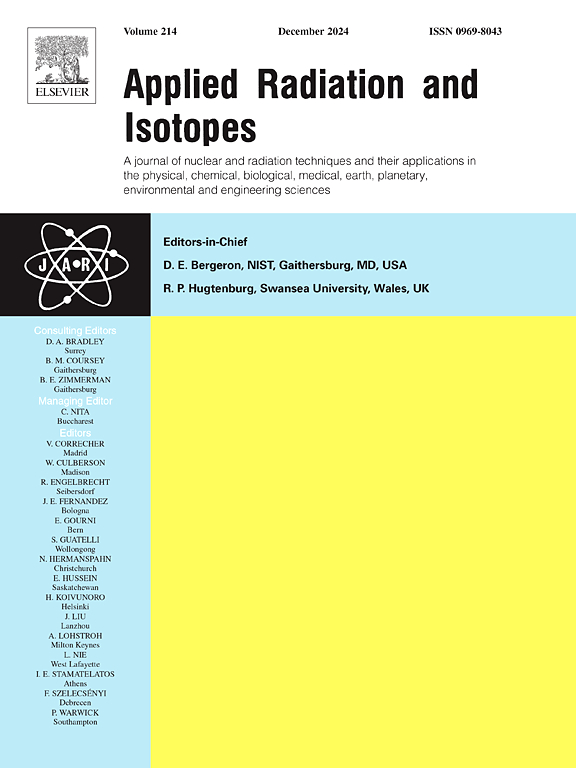Effects of Compton scattering on radiometric maps from Rio Preto area, Goiás State, Brazil
IF 1.6
3区 工程技术
Q3 CHEMISTRY, INORGANIC & NUCLEAR
引用次数: 0
Abstract
Gamma ray spectrometry measurements offer broad utility as a powerful method for identifying and quantifying radionuclides without the need of physicochemical sample preparation. Additionally, in situ readings are non-destructive, preserving the samples integrity. This study aimed to enhance the calibration steps of widely utilized gamma spectrometers based on NaI(Tl) scintillation detectors, involving calculation of combined uncertainties and assessment of systematic effects arising from the interaction of gamma radiation with matter, emphasizing the Compton interference in the gamma spectra. Radiometric data in 272 rock samples from Rio Preto Project developed at Goiás State, Brazil, spanning from 1995 to 2001, were obtained by means of a benchtop gamma spectrometer installed at LABIDRO-Isotopes and Hydrochemistry Laboratory, IGCE-UNESP, Rio Claro (SP), Brazil. The obtained dataset alllowed determine gamma interference factors within the spectral windows of natural radionuclides [K(40K), eU(214Bi), and eTh(208Tl)]. Furthermore, isoline maps were constructed using the geostatistical “minimum curvature” model to data analysis after removal of the Compton interference in spectral windows. Geostatistical models were employed to map their distribution in the study area, contributing to the refinement of procedures adopted for plotting survey/monitoring maps devoted to exploration/environmental purposes, thus, improving the accuracy and comprehension of gamma spectrometric data.
康普顿散射对巴西Goiás州里约热内卢Preto地区辐射测量图的影响
伽马射线能谱测量作为一种不需要物理化学样品制备的鉴定和定量放射性核素的有力方法,具有广泛的实用性。此外,原位读数是非破坏性的,保持了样品的完整性。本研究旨在提高基于NaI(Tl)闪烁探测器的广泛使用的伽玛光谱仪的校准步骤,包括计算伽玛辐射与物质相互作用引起的组合不确定度和系统效应的评估,并强调伽玛光谱中的康普顿干扰。利用安装在巴西里约热内卢Claro (SP) IGCE-UNESP labidro -同位素和水化学实验室的台式伽玛光谱仪,获得了1995年至2001年巴西Goiás State开发的里约热内卢Preto项目272个岩石样品的辐射测量数据。获得的数据集允许确定天然放射性核素[K(40K), eU(214Bi)和eTh(208Tl)]光谱窗口内的γ干扰因子。此外,在去除光谱窗口的康普顿干扰后,利用地统计学“最小曲率”模型构建等值线图进行数据分析。利用地质统计模型来绘制它们在研究地区的分布,有助于改进绘制专门用于勘探/环境目的的调查/监测地图所采用的程序,从而提高伽马能谱数据的准确性和理解力。
本文章由计算机程序翻译,如有差异,请以英文原文为准。
求助全文
约1分钟内获得全文
求助全文
来源期刊

Applied Radiation and Isotopes
工程技术-核科学技术
CiteScore
3.00
自引率
12.50%
发文量
406
审稿时长
13.5 months
期刊介绍:
Applied Radiation and Isotopes provides a high quality medium for the publication of substantial, original and scientific and technological papers on the development and peaceful application of nuclear, radiation and radionuclide techniques in chemistry, physics, biochemistry, biology, medicine, security, engineering and in the earth, planetary and environmental sciences, all including dosimetry. Nuclear techniques are defined in the broadest sense and both experimental and theoretical papers are welcome. They include the development and use of α- and β-particles, X-rays and γ-rays, neutrons and other nuclear particles and radiations from all sources, including radionuclides, synchrotron sources, cyclotrons and reactors and from the natural environment.
The journal aims to publish papers with significance to an international audience, containing substantial novelty and scientific impact. The Editors reserve the rights to reject, with or without external review, papers that do not meet these criteria.
Papers dealing with radiation processing, i.e., where radiation is used to bring about a biological, chemical or physical change in a material, should be directed to our sister journal Radiation Physics and Chemistry.
 求助内容:
求助内容: 应助结果提醒方式:
应助结果提醒方式:


